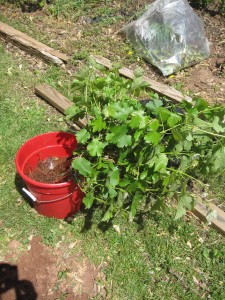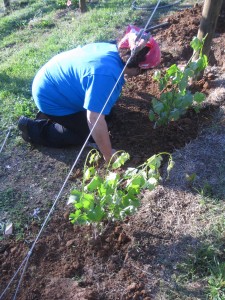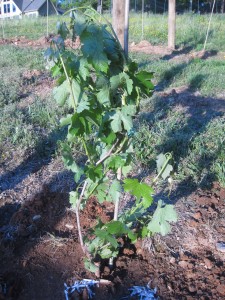The Great Experiment — Transplanting Cab Franc
Another busy weekend in the vineyard. We transplanted four Cab Franc vines from Fairfax, researched and ordered a deer fence, and installed the bottom, or fruiting wire on our trellises in Afton. And, of course, we spent some time admiring the fruit of our labors from the previous few weeks – 150 new vines buried under mounds of dirt. The reds, which
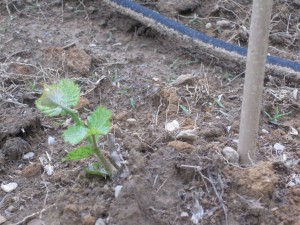
Three weeks after planting, the Viognier, pictured here, and the Petit Manseng, are emerging from the mounds of dirt that protected them from the spring frosts.
we planted two weekends ago, were still hidden away, but the whites we planted a week earlier – the Petit Manseng and the Viognier – were poking through the hills, and we were just thrilled to see them pushing through the earth! I have to say, they emerged from the mounds at just the right time, avoiding the frost that killed off our two prize Mammolo Toscano vines the previous weekend. Frost is an issue that we’ve been giving a lot of thought to after our experience this winter, and it influenced our decision on where to locate the fruiting wire. More on that in a future post.
For today, I’ll simply focus on our grand experiment, the transplanting of four of our Cab Franc vines from Fairfax to the Afton vineyard. We had planted a total of seven Cab Francs in Fairfax to get a bit of hands on experience close to home. I suppose at the back of my mind I thought I might eventually make a little wine from those vines, but mostly I
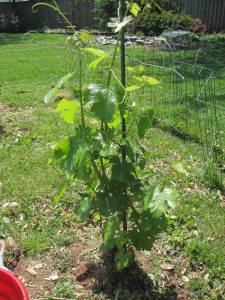
The Fairfax vines looked magnificent this Spring -- if a bit unruly. They need to be pruned, but that, I decided, would wait until they reached their new home.
wanted the experience of being able to go out in the evening after work to care for them and learn from that effort. We planted another five of the same clone and rootstock in Afton to see how the same vines would do in a different environment.
The Fairfax vines grew fast and they looked just beautiful. Clearly, the soil in Fairfax is rich, lending itself to high vigor growth. That’s good and bad, but probably mostly bad. It’s great to see the vines shoot up quickly, but ideally, we’d like them to struggle a bit so that the energy of the plant goes toward the grapes, not the vine itself. Left to its own, the vine will grow as high as it can find support – up a tree, for example, pushing toward the sunlight – but spectacular as that vine might be, it’s not going to give you much, if anything, in the way of fruit.
By contrast, the Nelson vines were much more restrained in their
growth. If the Fairfax group seemed to be growing too quickly, we worried that the Nelson vines would never amount to anything at all. By the end of last year, they were not as tall as the Fairfax vines, but I convinced myself they had expended their energy in developing a solid root system, which is what we want them to do in the first year.
In any event, we didn’t expect we would ever harvest enough grapes in Fairfax to make a decent amount of wine, so moving them seemed to be a good idea. Wes Hagen, of Clos Pepe Vineyards, and a columnist for WineMaker magazine, gave us the idea (although he can’t be blamed for any failures in the way we executed it). He recommends that you order more vines
than you intend to plant, with the excess going into a small plot of ground near the vineyard. Since every vineyard experiences the loss of 1 or 2 percent of the vines it plants, the extra vines can be dug up and replanted in place of the vines that didn’t make it.
So, why not try moving the Fairfax vines? They looked incredibly healthy this year. The leaves were free from disease and they seemed just about perfect. In half-hour before we left for Afton, I dug up four of them, put them in a bucket of water and then moved them into a watertight plastic garbage bag, with the roots wrapped in wet, shredded newsprint. They went into shock right away, with the leaves drooping
noticeably, but we were only two hours away from Afton, and I figured we’d have them in the ground shortly after we arrived.
We planted them immediately, and while they still appeared in shock from being moved, they weren’t any worse by evening or the next day. Right after planting, we gave them water, and for a bonus, it rained that evening, dropping an inch or so of water onto the vineyard.
We’ll know better in a week, when we return to Afton, if they’ll make it. But whether they live or die – and we fervently hope they live – it was a bit of an experiment, and another step on the road to learning how to manage a vineyard. Hopefully, the great experiment won’t turn out to be the grand flop.
Category: All Posts, Viticulture

